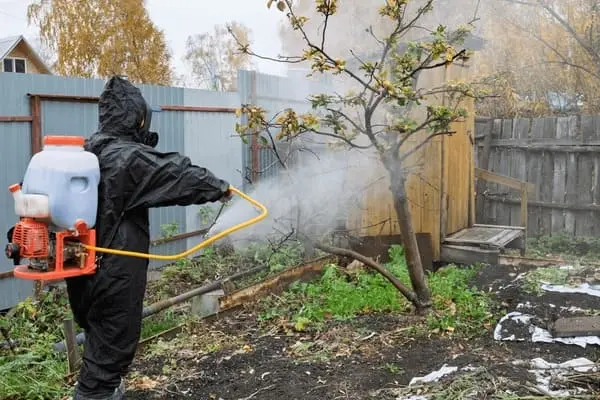-
Govind Bhawan,Kolkata - 700001
Govind Bhawan,Kolkata - 700001

Knowing when to opt for chemical pest treatments ensures effective pest control with minimal risk. Learn expert insights from the Best Pest Control Company in Kolkata on safe timing, benefits, and precautions for lasting protection.
Pests are silent invaders that can quickly turn a clean, comfortable space into a source of stress and discomfort. From termites chewing through wood to mosquitoes buzzing around corners, infestations not only cause damage but also carry significant health risks. Among the many pest control methods available, chemical pest treatments are often considered the most effective — but knowing when to choose them makes all the difference.
This guide explores when chemical solutions are truly necessary, how to use them safely, and why timing plays a critical role in keeping your environment pest-free.

Chemical pest treatments refer to the controlled use of insecticides or pesticides designed to eliminate unwanted pests at different stages of their life cycle — eggs, larvae, and adults. These treatments can come in various forms, such as:
The purpose of such treatments isn’t just to kill pests but also to prevent recurrence and create a barrier that deters new infestations.
Using chemicals at the wrong time can lead to multiple problems — from ineffective results to unnecessary exposure to toxic substances. Overuse or improper timing may also cause:
Hence, understanding when to opt for chemical pest treatments is the key to maintaining a balance between effectiveness and safety.

Certain scenarios make chemical control essential, especially when other methods fail to deliver results.
If you’ve tried natural remedies, traps, or routine cleaning and the problem persists, it’s a clear sign that the infestation has gone beyond basic control.
Common examples include:
In such cases, chemical-based treatments ensure a thorough and lasting solution.
Pests are not just unpleasant — they can spread diseases and allergies.
For instance:
Chemical intervention becomes necessary when infestations start posing direct threats to health or hygiene.
Monsoon season provides ideal conditions for pests to breed — moisture, warmth, and hiding spots.
Opting for chemical pest treatments post-monsoon helps:
It’s a crucial preventive measure for both homes and offices.
Whether it’s a new apartment or an old one being handed over to tenants, pre-occupancy pest treatment is essential. It ensures:
In commercial sectors — like food processing, hospitality, and healthcare — maintaining hygiene standards is non-negotiable. Scheduled chemical pest treatments help meet industry regulations while keeping workspaces safe for staff and customers alike.
Chemical pest control can be highly effective, but only when handled responsibly. Professionals follow a systematic approach to reduce health and environmental risks.
Important precautions include:
Modern products often contain micro-encapsulated chemicals, releasing active ingredients slowly for longer-lasting effects and greater safety.
When used at the right time and in the right way, these treatments offer multiple advantages:
In short, chemical solutions are often the last but most reliable line of defense when infestations grow out of control.
Modern pest management has evolved beyond harsh, toxic chemicals. Today’s chemical pest treatments are:
Technology has made treatments smarter, safer, and more efficient than ever before.
While powerful, chemical methods aren’t always the best first step. You might want to skip or delay them if:
Professionals typically recommend chemical intervention only when all other measures prove insufficient.
Before any treatment, experts conduct a detailed inspection to assess:
Based on these findings, a customized solution is applied to ensure maximum effectiveness with minimum risk.
Reliable pest management requires the right balance of expertise, safety, and science. Certified professionals use regulated chemicals, follow industry-standard safety protocols, and apply methods tailored to each environment.
A trusted name like Pestonix demonstrates how proper training, eco-conscious choices, and experience can make chemical pest control both safe and sustainable for every home and business.

Q1. Are chemical pest treatments harmful to humans?
Not when applied correctly. Modern chemicals are safer and eco-compliant, but professionals always recommend vacating treated areas temporarily.
Q2. How long do the effects of chemical pest control last?
Typically between 3 to 6 months, depending on the severity of the infestation and environmental factors.
Q3. Can I apply chemical pest treatments myself?
DIY kits exist, but improper use can cause health issues or make the treatment ineffective. Professional application ensures both safety and success.
Q4. Do chemical pest treatments have any odor?
Most modern chemicals are low-odor or odorless, designed for comfort and minimal disruption.
Q5. How can I prepare my home before treatment?
Remove food, cover utensils, and keep pets away from treated areas. Ventilate the space well after application.
Knowing when to opt for chemical pest treatments helps protect not just your property but also your health and peace of mind. Chemical methods, when used at the right time and handled by trained experts, deliver long-term relief and ensure hygiene without compromising safety.
By acting proactively and relying on experienced professionals, you can create a home or workspace that’s clean, safe, and entirely pest-free — today and in the seasons to come.